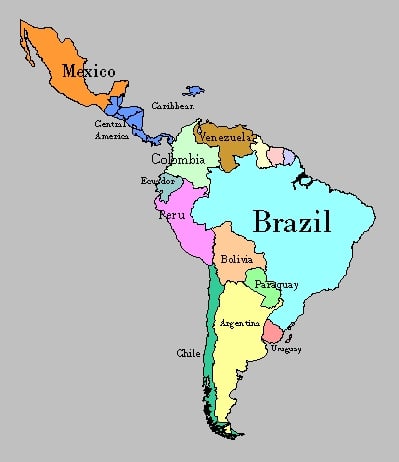THIS year marks the 200th anniversary of the start of Latin America’s struggle for political independence against the Spanish crown. Outsiders might be forgiven for concluding that there is not much to celebrate. In Mexico, which marks its bicentennial next week, drug gangs have met a government crackdown with mayhem on a scale not seen since the country’s revolution of a century ago. The recent discovery of the corpses of 72 would-be migrants, some from as far south as Brazil, in a barn in northern Mexico not only marked a new low in the violence. It was also a reminder that some Latin Americans are still so frustrated by the lack of opportunity in their own countries that they run terrible risks in search of that elusive American dream north of the border.
Democracy may have replaced the dictators of old—everywhere except in the Castros’ Cuba—but other Latin American vices such as corruption and injustice seem as entrenched as ever. And so do caudillos: in Venezuela Hugo Chávez, having squandered a vast oil windfall, is trying to bully his way to an ugly victory in a legislative election later this month.
Yet look beyond the headlines, and, as our special report shows, something remarkable is happening in Latin America. In the five years to 2008 the region’s economies grew at an annual average rate of 5.5%, while inflation was in single digits. The financial crisis briefly interrupted this growth, but it was the first in living memory in which Latin America was an innocent bystander, not a protagonist. This year the region’s economy will again expand by more than 5%. Economic growth is going hand in hand with social progress. Tens of millions of Latin Americans have climbed out of poverty and joined a swelling lower-middle class. Although income distribution remains more unequal than anywhere else in the world, it is at least getting less so in most countries. While Latin American squabbling politicians blather on about integration, the region’s businesses are quietly getting on with the job—witness the emerging cohort of multilatinas.
As they face difficulties in an increasingly truculent China, no wonder multinationals from the rich world are starting to look at Latin America with fresh interest. Sir Martin Sorrell, a British adman, talks of the dawn of a “Latin American decade”. Brazil, the region’s powerhouse, is the cause of much of the excitement. But Chile, Colombia and Peru are growing as handsomely and even Mexican society is forging ahead, despite the drug violence and the deeper recession visited on it by its ties to the more sickly economy in the United States.
Two things lie behind Latin America’s renaissance. The first is the appetite of China and India for the raw materials with which the continent is richly endowed. But the second is the improvement in economic management that has brought stability to a region long hobbled by inflation and has fostered a rapid, and so far sustainable, expansion of credit from well-regulated banking systems. Between them, these two things have created a virtuous circle in which rising exports are balanced by a growing domestic market. Because they were more fiscally responsible during the past boom than in previous ones, governments were able to afford stimulus measures during the recession. There is a lesson here for southern Europe: Latin America reacted to its sovereign-debt crisis of the 1980s with radical reform, which eventually paid off.
Much has been done; but there is much still to do. Building on this success demands new thinking, both within Latin America and north of the Rio Grande.
The danger for Latin America is complacency. Compared with much of Asia, Latin America continues to suffer from self-inflicted handicaps: except in farming, productivity is growing more slowly than elsewhere. The region neither saves and invests sufficiently, nor educates and innovates enough. Thanks largely to baroque regulation, half the labour force toils in the informal economy, unable to reap the productivity gains that come from technology and greater scale.
Fixing these problems requires Latin America’s political leaders to rediscover an appetite for reform. Democracy has brought a welcome improvement in social policy: governments are spending on the previously neglected poor, partly through conditional cash-transfer schemes, a pioneering Latin American initiative. But more needs to be done, especially to improve schools and health care, if everyone is to have the chance to get ahead. Also needed is a grand bargain to tackle the informal economy, in which labour-market reform is linked to a stronger social safety-net. And, even if some things like infrastructure and research and development plainly need more government spending, the worry is that triumphalism over escaping the financial crisis may prompt a return to a bigger, more old-fashioned state role in the economy—despite the failure of these policies in the region in the past.
Getting these things right will be easier if relations with the United States improve. Latin America needs to shed its old chippiness, manifest in Mr Chávez’s obsession with being in the hated yanqui’s “backyard”. More sensible powers, notably Brazil, should be much louder opponents of this nonsense. As they start to pull their weight on the world stage, working with the United States will become ever more important.
The attitude of the United States needs to change too. Worries about crime and migration—symbolised by the wall it is building across its southern border—are leading it to focus on the risks in its relationship with the neighbours more than on the opportunities. This is both odd, given that Latinos are already the second-largest ethnic group north of the border (see article), and self-defeating: the more open the United States is towards Latin America, the greater the chances of creating the prosperity which in the end is the best protection against conflict and disorder. After two centuries of lagging behind, the southern and central parts of the Americas are at last fulfilling their potential. To help cement that success, their northern cousins should build bridges, not walls.

